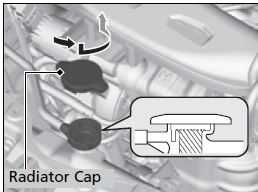Honda Civic Hatchback 2022 Engine Coolant User Manual
The engine coolant in the Honda Civic Hatchback 2022 is a vital component of the vehicle’s cooling system. It plays a crucial role in regulating the engine’s temperature and preventing overheating. The coolant circulates through the engine, absorbing excess heat and transferring it to the radiator where it is dissipated into the air.
The Honda Civic Hatchback 2022 specifically uses Honda Long Life Coolant, which is an ethylene glycol-based coolant designed to provide efficient heat transfer and long-lasting performance. This coolant is formulated to meet Honda’s specifications and requirements for optimal engine cooling and protection.
It is important to maintain the proper coolant level and quality in the Honda Civic Hatchback 2022 to ensure optimal engine performance and prevent potential issues such as overheating or corrosion. Regular coolant checks, top-ups, and coolant changes according to the manufacturer’s recommendations are essential for the longevity and reliability of the cooling system.
When handling engine coolant, it is crucial to follow safety precautions, including avoiding direct contact with the coolant, using protective gloves, and ensuring proper disposal of used coolant. It is recommended to use a mixture of Honda Long Life Coolant and distilled water in a 50/50 ratio, and tap water should be avoided due to its mineral content that can potentially affect the coolant’s performance.
Monitoring the coolant level, checking for any signs of coolant leaks, and promptly addressing any cooling system issues are important steps to keep the engine coolant in the Honda Civic Hatchback 2022 functioning optimally. Regular maintenance and following the manufacturer’s guidelines will help ensure the cooling system’s efficiency and the overall performance of the vehicle.
Engine Coolant
Specified coolant: Honda Long Life Antifreeze/Coolant Type
This coolant is premixed with 50% antifreeze and 50% water. Do not add any straight antifreeze or water. We recommend you check the engine coolant level every time you refuel. Check the reserve tank first. If it is completely empty, also check the coolant level in the radiator. Add the engine coolant accordingly.
- Make sure the engine and radiator are cool.
- Check the amount of coolant in the reserve tank. If the coolant level is below the MIN mark, add the specified coolant until it reaches the MAX mark.
- Inspect the cooling system for leaks.
Reserve Tank
WARNING
Removing the radiator cap while the engine is hot can cause the coolant to spray out, seriously scalding you. Always let the engine and radiator cool down before removing the radiator cap.
NOTICE
Genuine Honda engine coolant is a 50/50 mixture of antifreeze and water that can withstand freezing at temperatures as low as about −31°F (−35°C). If your vehicle is consistently subjected to temperatures below this, the concentration of antifreeze in the coolant should be increased. Consult a dealer for details. If Honda antifreeze/coolant is not available, you may use another major brand of non-silicate coolant as a temporary replacement. Check that it is a high quality coolant recommended for aluminum engines. Continued use of any non-Honda coolant can result in corrosion, causing the cooling system to malfunction or fail. Have the cooling system flushed and refilled with Honda antifreeze/coolant as soon as possible.
Radiator
- Make sure the engine and radiator are cool.
- Turn the radiator cap 1/8 turn counter-clockwise and relieve any pressure in the cooling system.
- Push down and turn the radiator cap counterclockwise to remove it.
- The coolant level should be up to the base of the filler neck. Add coolant if it is low.
- Put the radiator cap back on, and tighten it fully.
Do not add rust inhibitors or other additives to your vehicle’s cooling system. They may not be compatible with the coolant or with the engine components.
NOTICE
Pour the fluid slowly and carefully so you do not spill any. Clean up any spills immediately; they can damage components in the engine compartment.
Transmission Fluid
Continuously variable transmission models
Specified fluid: Honda HCF
Have a dealer check the fluid level and replace if necessary. Do not attempt to check or change the continuously variable transmission fluid yourself.
Manual transmission models
Specified fluid: Honda MTF
Have a dealer check the fluid level and replace if necessary. Do not attempt to check or change the manual transmission fluid yourself.
NOTICE
Do not mix Honda HCF-2 with other transmission fluids. Using a transmission fluid other than Honda HCF-2 may adversely affect the operation and durability of your vehicle’s transmission, and damage the transmission. Any damage caused by using a transmission fluid that is not equivalent to Honda HCF-2 is not covered by Honda’s new vehicle limited warranty.
NOTICE
If Honda MTF is not available, you may use the API-certificated SAE 0W-20 or 5W-20 viscosity motor oil as a temporary measure. Replace with MTF as soon as possible. Motor oil does not contain the proper additives for the transmission and continued use can cause decreased shifting performance and lead to transmission damage.
Brake/Clutch Fluid
Specified fluid: Honda Heavy Duty Brake Fluid DOT
Checking the Brake Fluid
The fluid level should be between the MIN and MAX marks on the side of the reserve tank.
Manual transmission models
The brake fluid reserve tank is also used for your vehicle’s clutch fluid. As long as you keep the brake fluid level as instructed above, there is no need for checking the clutch fluid level.
NOTICE
Brake fluid marked DOT 5 is not compatible with your vehicle’s braking system and can cause extensive damage. If the specified brake fluid is not available, you should use only DOT 3 or DOT 4 fluid from a sealed container as a temporary replacement. Using any non-Honda brake fluid can cause corrosion and decrease the longevity of the system. Have the brake system flushed and refilled with Honda Heavy Duty Brake Fluid DOT 3 as soon as possible. If the brake fluid level is at or below the MIN mark, have a dealer inspect the vehicle for leaks or worn brake pads as soon as possible.
Q &A
Q1: What type of engine coolant does the Honda Civic Hatchback 2022 use?
A1: The Honda Civic Hatchback 2022 uses Honda Long Life Coolant, which is a type of ethylene glycol-based coolant.
Q2: What is the recommended coolant capacity for the Honda Civic Hatchback 2022?
A2: The recommended coolant capacity for the Honda Civic Hatchback 2022 is approximately 5.7 liters (6.0 quarts).
Q3: What is the recommended coolant mixture ratio for the Honda Civic Hatchback 2022?
A3: The recommended coolant mixture ratio for the Honda Civic Hatchback 2022 is a 50/50 mixture of Honda Long Life Coolant and distilled water.
Q4: Can I use a different brand of coolant in the Honda Civic Hatchback 2022?
A4: It is recommended to use Honda Long Life Coolant in the Honda Civic Hatchback 2022. However, if Honda Long Life Coolant is not available, you can use a high-quality ethylene glycol-based coolant that meets Honda’s specifications.
Q5: How often should I change the engine coolant in the Honda Civic Hatchback 2022?
A5: The recommended interval for changing the engine coolant in the Honda Civic Hatchback 2022 is every 120,000 miles or 10 years, whichever comes first.
Q6: How can I check the coolant level in the Honda Civic Hatchback 2022?
A6: To check the coolant level in the Honda Civic Hatchback 2022, open the hood and locate the coolant reservoir. The reservoir has markings indicating the minimum and maximum levels. The coolant level should be between these marks when the engine is cool.
Q7: Can I mix different types of coolant in the Honda Civic Hatchback 2022?
A7: It is not recommended to mix different types of coolant in the Honda Civic Hatchback 2022. It is best to use the same type of coolant throughout the cooling system.
Q8: How can I add coolant to the Honda Civic Hatchback 2022?
A8: To add coolant to the Honda Civic Hatchback 2022, open the hood and locate the coolant reservoir. If the coolant level is below the minimum mark, remove the cap on the reservoir and add a mixture of Honda Long Life Coolant and distilled water until the level reaches the maximum mark.
Q9: What should I do if the engine coolant temperature warning light comes on?
A9: If the engine coolant temperature warning light comes on while driving, it indicates that the engine is overheating. Safely pull over, turn off the engine, and allow it to cool down. Check the coolant level and add coolant if necessary. If the problem persists, consult a Honda dealership or qualified mechanic.
Q10: Can I use tap water instead of distilled water to mix with the coolant?
A10: It is recommended to use distilled water when mixing with the coolant in the Honda Civic Hatchback 2022. Tap water may contain minerals and impurities that can affect the performance and longevity of the coolant.
Q11: Does the Honda Civic Hatchback 2022 have a coolant temperature gauge?
A11: Yes, the Honda Civic Hatchback 2022 is equipped with a coolant temperature gauge. It displays the temperature of the engine coolant, allowing you to monitor its operating temperature.
Q12: What should I do if I accidentally spill coolant on the engine or other hot components?
A12: If you accidentally spill coolant on the engine or other hot components, allow them to cool down before attempting to clean the spill. Use a clean cloth or towel to absorb the coolant and clean the affected area. Avoid direct contact with the coolant to prevent skin irritation.
Q13: How do I properly dispose of used coolant from the Honda Civic Hatchback 2022?
A13: Used coolant should never be poured down the drain, onto the ground, or into storm sewers. It contains harmful chemicals. It is best to take the used coolant to a certified recycling center or a local authorized Honda dealership for proper disposal.
Q14: Can I use a coolant flush or radiator cleaner in the Honda Civic Hatchback 2022?
A14: It is generally not necessary to use a coolant flush or radiator cleaner in the Honda Civic Hatchback 2022 unless recommended by a qualified mechanic. Regular maintenance and coolant changes should be sufficient to keep the cooling system in good condition.
Q15: Are there any special precautions I should take when working with engine coolant in the Honda Civic Hatchback 2022?
A15: When working with engine coolant, it is important to follow safety precautions. Ensure that the engine is cool before removing the coolant reservoir cap. Avoid direct contact with the coolant and clean any spills immediately. Keep coolant out of reach of children and pets, as it is toxic. Follow the manufacturer’s instructions and consult the vehicle’s manual for specific guidelines.
Useful Links
View Full User Guide: Honda Civic Hatchback 2022 User Manual
Download Manuals: https://owners.honda.com/vehicle-information/manuals


